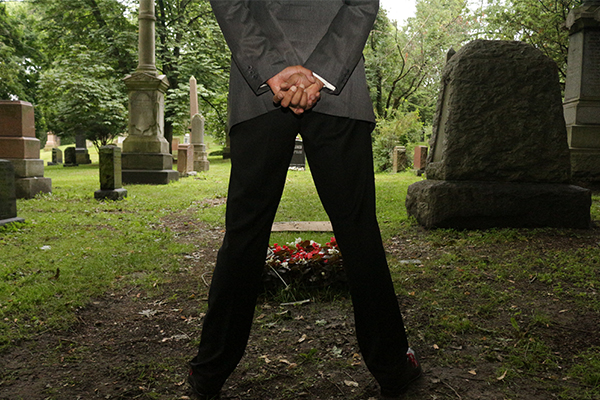George Romero spent the last 15 years of his life as a Torontonian
The smell of rained-upon soil filled my nostrils as I, and friend James Russell ventured up the drive of the Toronto Necropolis.

PAYING OUR RESPECTS: An unmarked grave is the final resting place of George A. Romero, the godfather of zombie films.
It’s been a year since Night of the Living Dead director George A. Romero became one with the earth, and as fans of his work, we made a pilgrimage to his final resting place at the Cabbagetown cemetery.
Riverdale Farm was across the street, and as we shuffled up to his site, we noticed there was no marker, save for the plot number. A toad hopped away from my footsteps and I figured it was a transient from the ponds from yonder Bayview extension.
There is no large swath of land here. It’s no Mount Pleasant Cemetery, where his service was held in 2017, but it holds its own with people who shaped the city: William Lyon Mackenzie, Jack Layton, Ralph Day and, one for all the dinosaur fans, Joseph Burr Tyrrell.
Beyond the gabled entrance of the Necropolis, and the patch of impatiens nestled at the foot of Romero’s grave, there is nothing else. My trek here was initially an idea given to me by Canadian historian and Lawrence Park resident John Robert Colombo in a recent conversation.
I mused to myself that the closest headstone reads Baskin. I laugh, as that’s the title of a Turkish horror movie. Perhaps it’s meant to be?
In 2004, Romero moved from his Steeltown roots in Pittsburgh, Penn. to Toronto. He gained Canadian citizenship in 2009 and did a fair chunk of his later work around the city.
It’s bizarre that the godfather of the zombie genre would make his home in this city, but he did. It’s said that a lot of his colleagues shuffled off to New York and Los Angeles, away from the ‘Burgh, leaving Romero to go north.
He filmed Diary of the Dead in Markham and was a regular at the FanExpo.
As I stood at his grave though, a year after his descent, I half expected James to say, “They’re coming to get you … Brian.”
But, alas, we were silent as the grave.
Perhaps the Mount Pleasant Group which operates the Necropolis knew more about the absent headstone, and I would later ask Rick Cowan, assistant vice president of marketing and communications, what the reason was.
“Decisions to memorialize an individual’s grave are very personal and are the purview of the deceased’s family,” was the note I received the morning after.
Hopefully, something will be erected, whether it be modest or as garish as his nightmarish hordes, to memorialize the man who gave us the modern interpretation of the zombie.

